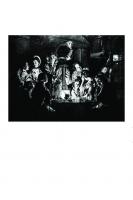Boston After Bulfinch: An Account Of Its Architecture, 1800-1900 [Reprint 2014 ed.] 9780674182318, 9780674334106
177 108 8MB
English Pages 129 [168] Year 1946
FOREWORD
CONTENTS
PLATES
CHAPTER I. BEGINNINGS
CHAPTER II. FEDERALIST
CHAPTER III. GREEK REVIVAL
CHAPTER IV. AMERICAN GOTHIC
CHAPTER V. PLAIN AMERICAN
CHAPTER VI. EXPANSION
CHAPTER VII. THE FRENCH INFLUENCE
CHAPTER VIII. VICTORIAN GOTHIC
CHAPTER IX. ROMANESQUE
CHAPTER Χ. RENAISSANCE
CHAPTER XI. THE STEEL FRAME
CHAPTER XII. CONCLUSION
APPENDIX
INDEX
Recommend Papers
![Boston After Bulfinch: An Account Of Its Architecture, 1800-1900 [Reprint 2014 ed.]
9780674182318, 9780674334106](https://ebin.pub/img/200x200/boston-after-bulfinch-an-account-of-its-architecture-1800-1900-reprint-2014nbsped-9780674182318-9780674334106.jpg)
- Author / Uploaded
- Walter H. Kilham
File loading please wait...
Citation preview
BOSTON AFTER BULFINCH
LONDON : GEOFFREY CUMBERLEGE OXFORD UNIVERSITY PRESS
UNIVERSITY
HALL
ΜΜΤΜΆ
8V&YXB0B
AN ACCOUNT OF ITS ARCHITECTURE 1800-1900
BY WALTER H. KILHAM FELLOW OF T H E A M E R I C A N I N S T I T U T E OF A R C H I T E C T S
C A M B R I D G E
HARVARD U N I V E R S I T Y 1 9
4 6
PRESS
COPYRIGHT,
1946
B Y THE PRESIDENT AND FELLOWS OF HARVARD COLLEGE
PRINTED IN THE UNITED STATES OF AMERICA
TO T H E
MEMBERS
OF T H E
BROOKLINE
THURSDAY
CLUB, W H O S E INTEREST M A K E S POSSIBLE ITS P U B LICATION, THIS BOOK IS AFFECTIONATELY INSCRIBED
FOREWORD
WRITERS on architecture have usually avoided saying very much about the work of the nineteenth century, especially in the United States, but as a matter of fact this era of rapid expansion provides in its architecture a highly instructive picture of the developing culture of the nation. Boston, by reason of its predominance in wealth and cultivation, took a leading part in this architectural growth and produced in Bulfinch at the beginning of the century and Richardson toward the end two major stars whose work gave her a national reputation. Even though historians, in chronicling the accomplishments of a people, generally confine themselves to wars and political or religious controversies, it is likely that the buildings they put up give a better clue to their achievements and thoughts than anything else they do. This essay seeks to collect from widely scattered sources the story of the Boston buildings of this era and the architects who created them. "The Victorian Age," it is often called with a patronizing smile, but let it be remembered that these architects, Bulfinch, Parris, Willard and Rogers, Bryant, Bradlee and Gilman, Richardson, Cummings, McKim, and the rest changed a tight little seaport into a handsome, stately, and dignified city, creating something which ever since has been a thing of beauty and usefulness, and it would be difficult to prove that the present century has improved upon their work. The historical and literary story of Boston in the nineteenth century has often been told. This is an effort to present the architectural side before the names are forgotten and all the buildings demolished.
September 1945
CONTENTS
X.
BEGINNINGS
3
II.
FEDERALIST
8
III.
GREEK REVIVAL
19
IV.
AMERICAN
43
V. VI. VII.
PLAIN
GOTHIC
AMERICAN
EXPANSION
50 57
THE FRENCH
INFLUENCE
65
VICTORIAN GOTHIC
75
IX.
ROMANESQUE
80
X.
RENAISSANCE
87
T H E STEEL
97
VIII.
XI. XII.
FRAME
CONCLUSION
ΙΟΙ
INDEX
107
ix
PLATES
FRONTISPIECE—UNIVERSITY
HALL
·
HARVARJJ UNIVERSITY
Charles Bulfinch, architect. From a photograph in the possession of the author. I.
STATE HOUSE
Charles Bulfinch, architect. Athenaeum. II.
From an old print at the Boston
OLD NORTH CHURCH
William Price, architect. From a photograph in the possession of the author. OLD HOUSE IN ALDEN
STREET
From a sketch by the author made about 1890. III.
P L A N OF T H E TONTINE BUILDINGS
Franklin Street, Charles Bulfinch, architect. From an old print. COLONNADE ROW
·
TREMONT
STREET
Charles Bulfinch, architect. IV.
OTIS HOUSE
·
8 5 M O U N T VERNON STREET
Charles Bulfinch, architect. From a photograph in the possession of the author. TICKNOR HOUSE
·
9 PARK
STREET
Charles Bulfinch, architect. Courtesy of Η. A . B. S. V.
W E S T CHURCH
·
CAMBRIDGE STREET
Asher Benjamin, architect. From a photograph in the possession of the author. PARK STREET CHURCH
Peter Banner, architect. Courtesy of the Boston Athenaeum. VI.
54-55
BEACON STREET
Attributed to Asher Benjamin. Courtesy of the Boston Athenaeum. SOMERSET
CLUB
Alexander Parris, architect. From a photograph in the possession of the author. xi
xii
PLATES vii.
ST. PAUL'S CHURCH Alexander Parris, architect. From a photograph in the possession of the author. QUINCY MARKET Alexander Parris, architect. Athenaeum.
From an old print at the Boston
VIII. TREMONT HOUSE Isaiah Rogers, architect. From an old print at the Boston Athenaeum. CUSTOM HOUSE Ammi B. Young, architect. From an old print. IX.
LOUISBURG SQUARE From a photograph in the possession of the author. MERCHANTS EXCHANGE Isaiah Rogers, architect. From an old photograph.
X.
BUNKER HILL MONUMENT Solomon Willard, architect. From a photograph in the possession of the author. GATEWAY · GRANARY BURYING GROUND Solomon Willard, architect. Courtesy of Walker, Wise 8c Co., 1864. CHURCH OF ST. JOHN THE EVANGELIST Solomon Willard, architect. From a photograph in the possession of the author.
XI. HOUSE · LINWOOD STREET, ROXBURY From a photograph in the possession of the author. HASTINGS-LAWRENCE HOUSE · CAMBRIDGE From a photograph in the possession of the author. CAPTAINS' ROW · CHELSEA From a photograph in the possession of the author. XII.
PLAN OF QUINCY MARKET Courtesy of the State Street Trust Co. AMERICAN GOTHIC · CHELSEA From a photograph in the possession of the author.
XIII. OLD TRINITY CHURCH · SUMMER STREET George W . Brimmer, architect. From an old print. FITCHBURG RAILROAD STATION George M. Dexter, architect. Courtesy of Little, Brown & Co.
PLATES XIV.
xiii
FIRST MASONIC T E M P L E
Isaiah Rogers, architect. From an old print. SECOND MASONIC T E M P L E
Merrill G. Wheelock, architect. From an old print. xv.
ST. AUGUSTINE'S CHAPEL
From a sketch by the author. OAK HALL
From an old billhead. XVI.
BEACON HILL RESERVOIR
· PLAN AND SECTION
From N. J. Bradlee, "History of the Introduction of Pure Water into Boston." BEACON HILL RESERVOIR
Courtesy of Gleason's Pictorial. XVII.
BOSTON M U S E U M
Hammatt Billings, architect. Courtesy of Walker, Wise & Co. BOSTON M U S E U M
· INTERIOR OF LOBBY
Hammatt Billings, architect. Courtesy of Walker, Wise & Co. XVIII.
BOSTON ATHENAEUM
Edward C. Cabot, architect. Courtesy of the Boston Athenaeum. OLD PUBLIC LIBRARY
· BOYLSTON STREET
C. F. Kirby, architect. Courtesy of the Boston Athenaeum. XIX.
COMMERCIAL WHARF
From a photograph in the possession of the author. COMMERCIAL STREET
·
WAREHOUSES
From a photograph in the possession of the author. XX.
STATE STREET BLOCK
G. J. F. Bryant, architect. From a photograph in the possession of the author. STATE STREET BLOCK
·
DETAIL
G. J. F. Bryant, architect. From a photograph in the possession of the author. XXI.
REVERE HOUSE
Courtesy of the Boston Athenaeum. CAST IRON PORCH
· VALENTINE-FULLER HOUSE
·
From a photograph in the possession of the author.
CAMBRIDGE
PLATES
XIV XXII.
CITY
HALL
Bryant & Gilman, architects. Courtesy of the Boston Athenaeum. OLD POST OFFICE
A. B. Mullett, architect. Courtesy of the Boston Athenaeum. XXIII.
N E W ENGLAND M U T U A L BUILDINGS
·
POST OFFICE SQUARE
Left, Peabody & Stearns, Right, N . J. Bradlee, architects. Courtesy of Ticknor & Co. XXIV.
CITY
HOSPITAL
G . J. F. Bryant, architect. Courtesy of Walker, Wise & Co. 315
DARTMOUTH
STREET
From a photograph in the possession of the author. ARLINGTON STREET
CHURCH
Arthur Gilman, architect. Courtesy of Walker, Wise & Co. BOSTON ART C L U B
William Ralph Emerson, architect. From King's Dictionary of Boston, 1883 edition. XXV.
EQUITABLE BUILDING
·
MILK
STREET
Arthur Gilman, architect. From an old print. SECOND HORTICULTURAL H A L L
·
TREMONT
STREET
G. J. F. Bryant, architect. From an old print. XXVI.
N E W ENGLAND M U S E U M OF NATURAL HISTORY
William G. Preston, architect. From an old print. ROGERS BUILDING
·
BOYLSTON
STREET
William G. Preston, architect. XXVII.
BOSTON SKATING R I N K
From a photograph in the possession of the author. BOSTON & L O W E L L RAILROAD STATION
E. A. P. Newcomb, architect. From King's Dictionary of Boston, 1883 edition. ENGLISH HIGH AND LATIN SCHOOL
George A. Clough, architect. From King's Dictionary of Boston, 1883 edition. XXVIII.
MEMORIAL HALL
·
HARVARD U N I V E R S I T Y
·
DETAIL
Ware & Van Brunt, architects. Courtesy of Harvard Film Service. OLD M U S E U M OF F I N E ARTS
·
COPLEY SQUARE
Sturgis & Brigham, architects. Courtesy of the Boston Athenaeum.
XV
PLATES XXIX.
FIRST CHURCH W a r e & V a n Brunt, architects. From King's Dictionary 1883 edition.
of
Boston,
Dictionary
of
Boston,
Dictionary
of
Boston,
BOSTON & PROVIDENCE RAILROAD STATION Peabody & Stearns, architects. From King's 1883 edition. NEW OLD SOUTH CHURCH Cummings & Sears, architects. From King's 1883 edition. BAPTIST CHURCH
· CLARENDON STREET
Η . H . Richardson, architect. From a photograph in the possession of the author. XXX.
CATHEDRAL OF THE HOLY CROSS F. C . Keeley, architect. From King's edition.
Dictionary
of Boston,
1883
CENTRAL CONGREGATIONAL CHURCH R . M . Upjohn, architect. From a photograph in the possession of the author. XXXI.
BOSTON PUBLIC LIBRARY M c K i m , Mead & W h i t e , architects. Courtesy of the Boston Public Library.
XXXII.
PLAN OF COPLEY SQUARE A s suggested by M c K i m . Courtesy of T i c k n o r & C o . TRINITY CHURCH Η . H . Richardson, architect. Courtesy of T i c k n o r & C o .
ILLUSTRATIONS IN PLAN OF TREMONT HOUSE
TEXT
· FIRST FLOOR
Courtesy of G r a y & Bowen, 1830 M A P OF BACK BAY
·
Page 33
1825
From a drawing in the possession of the author
Page S9
BOSTON AFTER BULFINCH
CHAPTER I BEGINNINGS
STYLISTICALLY speaking, Boston architecture of the nineteenth century begins with the "Federalist" style of Bulfinch and his contemporaries and passes through the wellknown Greek Revival, American Gothic, and Mansard Roof styles to culminate in Richardson's Romanesque and finally revert again to the classic. No matter what the period, the style was fixed then, as now, purely and simply by fashion and nothing else. No distinctively American style was ever really in evidence, and quite possibly none ever will be, for as long as people lack definite religious and political convictions, and particularly as long as a lagging philosophy fails to catch up with runaway science, just so long will Americans be unable to create a style of their own as distinctive as the Grecian or the Gothic. Nevertheless, some of the nineteenth-century design was impressive, much of it was comfortable-looking, and a good deal was meritorious. I hope that this account of it may not only prove interesting, but also may possibly awaken a feeling of regret for some of the well-known buildings which we ourselves have seen disappear. At least I can claim that while Silas Lapham, George Apley, Η. M. Pulham, and the characters in Ward 8 walk unseen through these pages, none of the famous writers who have psychoanalyzed Boston and its people, from Howells through Robert Grant, John Marquand, and Joseph F. Dinneen, have ever tried to do much with the architecture of this middle period; this account may be the first attempt to chronicle it. It is a fact that each successive generation scorns the work of the generation immediately preceding, usually designating it as "terrible" or worse, and two to three generations must
4
BOSTON AFTER BULFINCH
pass before it is restored to sufficient favor to have books published about it. The architecture of Boston's middle stage has passed through this period of purgatory, and some of its buildings have already attained the dignity of highly regarded landmarks. Excepting Michelangelo and Sir Christopher Wren, it is very seldom that an architect's name lives long after his death. The names of distinctly mediocre poets and definitely incomprehensible painters become household words and are even taught to helpless children in the schools, but the name of even a fairly good architect disappears quickly into oblivion unless a broad-minded building committee happens to put it on a tablet, inconspicuously beneath those of the mayor and board of aldermen. This is probably for the best, since many an architect would willingly forget some of his early work; nevertheless the architect's name on a building may often be of interest to some future antiquarian, even if his part in its history is a minor one. In this essay the names of as many early Boston architects as I have been able to find are recorded, together with such facts about them as are available. Such names of builders as came to light are also included, not only in justice to the men without whose skill nothing could have been accomplished, but as a recognition of the fact that in early days architects' plans were far less complete than they are now and many details of construction and even design were left to the builder. Until Charles Bulfinch came upon the scene, about 1790, buildings were usually designed and constructed by "housewrights" who in a general way were the equivalent of the contractors of the present time. If a man wished to build he would perhaps summon two or three housewrights and tell them his ideas, after which each would make up some sort of a plan to submit along with his estimates. Naturally these would vary widely. Bulfinch was apparently the first
BEGINNINGS
5
to introduce the idea of having one plan as a basis for all to use alike in submitting estimates. From 1630, the year of the town's settlement, until the early 1700's we know very few of the names of the early builders, but crude pictures are extant which show that while the wooden Paul Revere house (1676), which still exists, was typical of many of the houses of the period, the town could show quite a number of much more pretentious ones, among which the Province House (1674), the FosterHutchinson house (1686), and the Cotton Mather houses are the best known. These were three-story brick mansions, the fa9ades of the last two adorned with Ionic pilasters which reached from base to cornice, a local treatment which does not appear in the Salem or Portsmouth work. While the houses mentioned have long since disappeared, a brick house of the same type, rather elegant in treatment with a flight of stone steps and a wrought-iron railing leading up to the front door, stood in Alden Street until the early 1900's and was sketched by the present writer. The gambrel roof which afforded much better attic space appeared early in the eighteenth century. The "Old Corner" house ( 1 7 1 2 ) at School and Washington Streets is probably the earliest of this type still standing, and the John Hancock house on Beacon Street, regrettably torn down in 1863, was doubtless the most famous. There must have been many others. T w o old brick houses which probably date from the early years of the eighteenth century, the Ebenezer Hancock house on Marshall's Lane and the Capen house on Union Street, were still standing in 1944. The earlier decades of the eighteenth century saw the erection of several important public buildings which are still standing. The name of the designer of the Old State House ( 1 7 1 3 ) whose unique and original fa
![The Architecture of Charles Bulfinch [Reprint 2014 ed.]
9780674182226, 9780674182219](https://ebin.pub/img/200x200/the-architecture-of-charles-bulfinch-reprint-2014nbsped-9780674182226-9780674182219.jpg)
![The Nieman Fellows Report: An Account of an Educational Experiment in Its Tenth Year [Reprint 2014 ed.]
9780674366756](https://ebin.pub/img/200x200/the-nieman-fellows-report-an-account-of-an-educational-experiment-in-its-tenth-year-reprint-2014nbsped-9780674366756.jpg)







